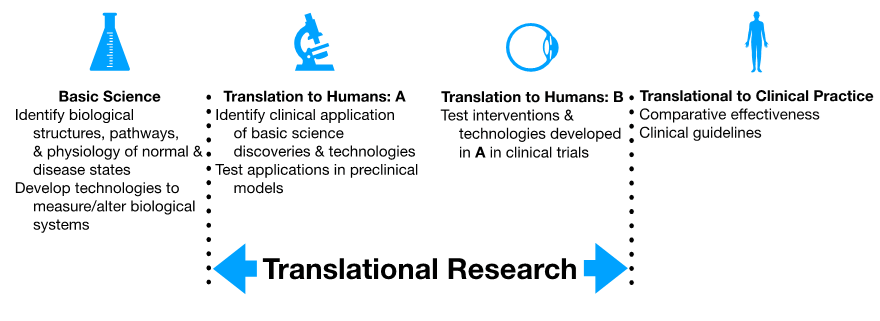Translational Research and ARVO's TVST Journal
Translational Vision Science and Technology (TVST) is ARVO's open access, online only, peer-reviewed journal highlights the multidisciplinary research that bridges the gap between basic research and clinical care.
What exactly is translational research, and where does it fit into the broad spectrum of scientific activity undertaken by the members of ARVO? As might be expected, experienced clinicians and scientists differ regarding the answer to this question. One answer is provided in the figure below. The dotted vertical lines are intended to convey the impression that the distinction between basic and early stage translational research is not always clear, nor is the distinction between late stage translational research and research focused on clinical practice.

Importance of translational research
The field of translational research is ever growing, as researchers discover new ways to strategically apply basic science to specialized fields, such as eye and vision research. As such, TVST is currently experiencing a phase of rapid growth. At the current rate, the number of submissions will have increased by 34% by July 2020 compared with the previous year. The acceptance rate is currently 40%.
Reflecting the field
TVST's associate editors and editorial board members are based throughout the world, reflecting the global breadth of ARVO's membership. All are highly experienced investigators who, together with a large cadre of conscientious reviewers, strive to provide authors with constructive observations concerning each submission.
Ensuring that scientists and researchers have access to the wealth of information in TVST is also a priority. Papers published in TVST are listed in PubMed, and we will apply for listing in Medline in mid-2020. While we do not yet know the impact factor for 2019, 2018's impact factor was c.2.5.
The future of TVST
The next issue of TVST will explore the opportunities and risks that artificial intelligence (AI) presents to the practice of ophthalmology and optometry. This special issue of TVST examines various aspects of AI, including the computational architecture underlying this discipline as well as some current applications to vision science and clinical care. While some papers are invited reviews and editorials by leading experts in the field, others are original research. We hope that these papers will make the field of AI more accessible to clinicians and scientists engaged in vision research and will stimulate additional original contributions in this area.
Marco Zarbin, MD, PhD, FARVO


